Management and Leadership Skills
VerifiedAdded on 2023/04/22
|6
|1281
|226
AI Summary
This essay evaluates the reasons causing workplace conflicts and approaches for effective conflict management. It discusses alternative dispute resolution, types of conflict styles, emotional intelligence theory, guanxi, and Ganqing.
Contribute Materials
Your contribution can guide someone’s learning journey. Share your
documents today.
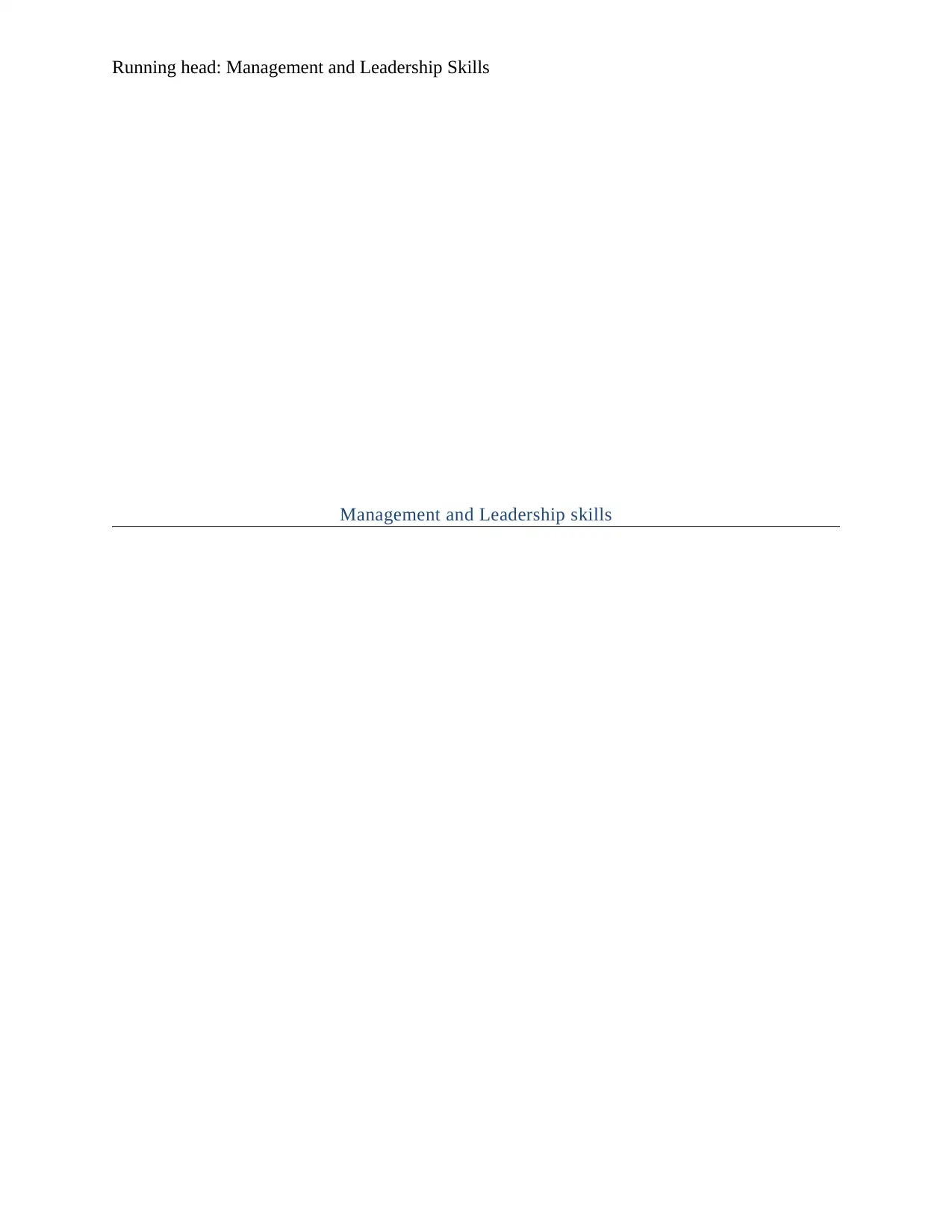
Running head: Management and Leadership Skills
Management and Leadership skills
Management and Leadership skills
Secure Best Marks with AI Grader
Need help grading? Try our AI Grader for instant feedback on your assignments.
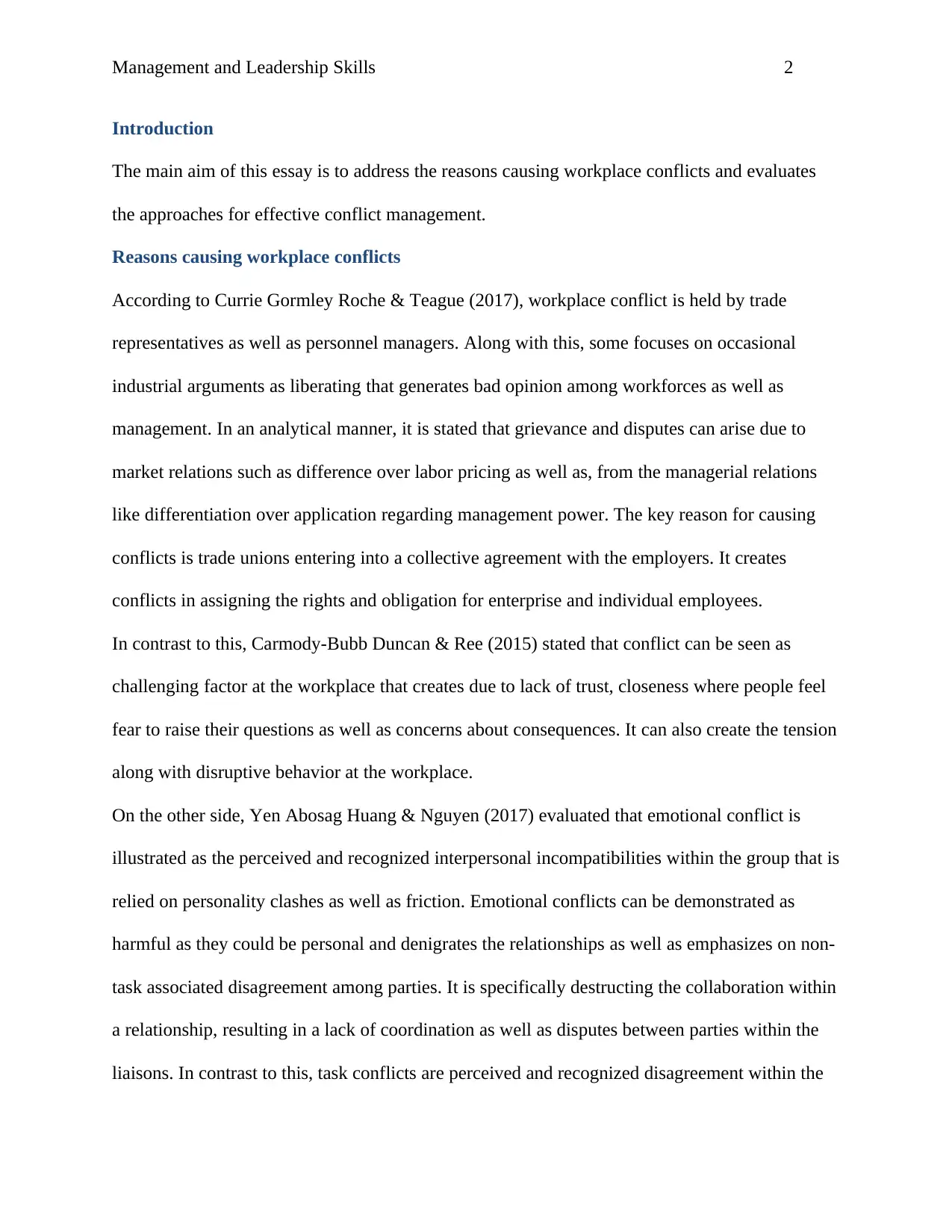
Management and Leadership Skills 2
Introduction
The main aim of this essay is to address the reasons causing workplace conflicts and evaluates
the approaches for effective conflict management.
Reasons causing workplace conflicts
According to Currie Gormley Roche & Teague (2017), workplace conflict is held by trade
representatives as well as personnel managers. Along with this, some focuses on occasional
industrial arguments as liberating that generates bad opinion among workforces as well as
management. In an analytical manner, it is stated that grievance and disputes can arise due to
market relations such as difference over labor pricing as well as, from the managerial relations
like differentiation over application regarding management power. The key reason for causing
conflicts is trade unions entering into a collective agreement with the employers. It creates
conflicts in assigning the rights and obligation for enterprise and individual employees.
In contrast to this, Carmody-Bubb Duncan & Ree (2015) stated that conflict can be seen as
challenging factor at the workplace that creates due to lack of trust, closeness where people feel
fear to raise their questions as well as concerns about consequences. It can also create the tension
along with disruptive behavior at the workplace.
On the other side, Yen Abosag Huang & Nguyen (2017) evaluated that emotional conflict is
illustrated as the perceived and recognized interpersonal incompatibilities within the group that is
relied on personality clashes as well as friction. Emotional conflicts can be demonstrated as
harmful as they could be personal and denigrates the relationships as well as emphasizes on non-
task associated disagreement among parties. It is specifically destructing the collaboration within
a relationship, resulting in a lack of coordination as well as disputes between parties within the
liaisons. In contrast to this, task conflicts are perceived and recognized disagreement within the
Introduction
The main aim of this essay is to address the reasons causing workplace conflicts and evaluates
the approaches for effective conflict management.
Reasons causing workplace conflicts
According to Currie Gormley Roche & Teague (2017), workplace conflict is held by trade
representatives as well as personnel managers. Along with this, some focuses on occasional
industrial arguments as liberating that generates bad opinion among workforces as well as
management. In an analytical manner, it is stated that grievance and disputes can arise due to
market relations such as difference over labor pricing as well as, from the managerial relations
like differentiation over application regarding management power. The key reason for causing
conflicts is trade unions entering into a collective agreement with the employers. It creates
conflicts in assigning the rights and obligation for enterprise and individual employees.
In contrast to this, Carmody-Bubb Duncan & Ree (2015) stated that conflict can be seen as
challenging factor at the workplace that creates due to lack of trust, closeness where people feel
fear to raise their questions as well as concerns about consequences. It can also create the tension
along with disruptive behavior at the workplace.
On the other side, Yen Abosag Huang & Nguyen (2017) evaluated that emotional conflict is
illustrated as the perceived and recognized interpersonal incompatibilities within the group that is
relied on personality clashes as well as friction. Emotional conflicts can be demonstrated as
harmful as they could be personal and denigrates the relationships as well as emphasizes on non-
task associated disagreement among parties. It is specifically destructing the collaboration within
a relationship, resulting in a lack of coordination as well as disputes between parties within the
liaisons. In contrast to this, task conflicts are perceived and recognized disagreement within the
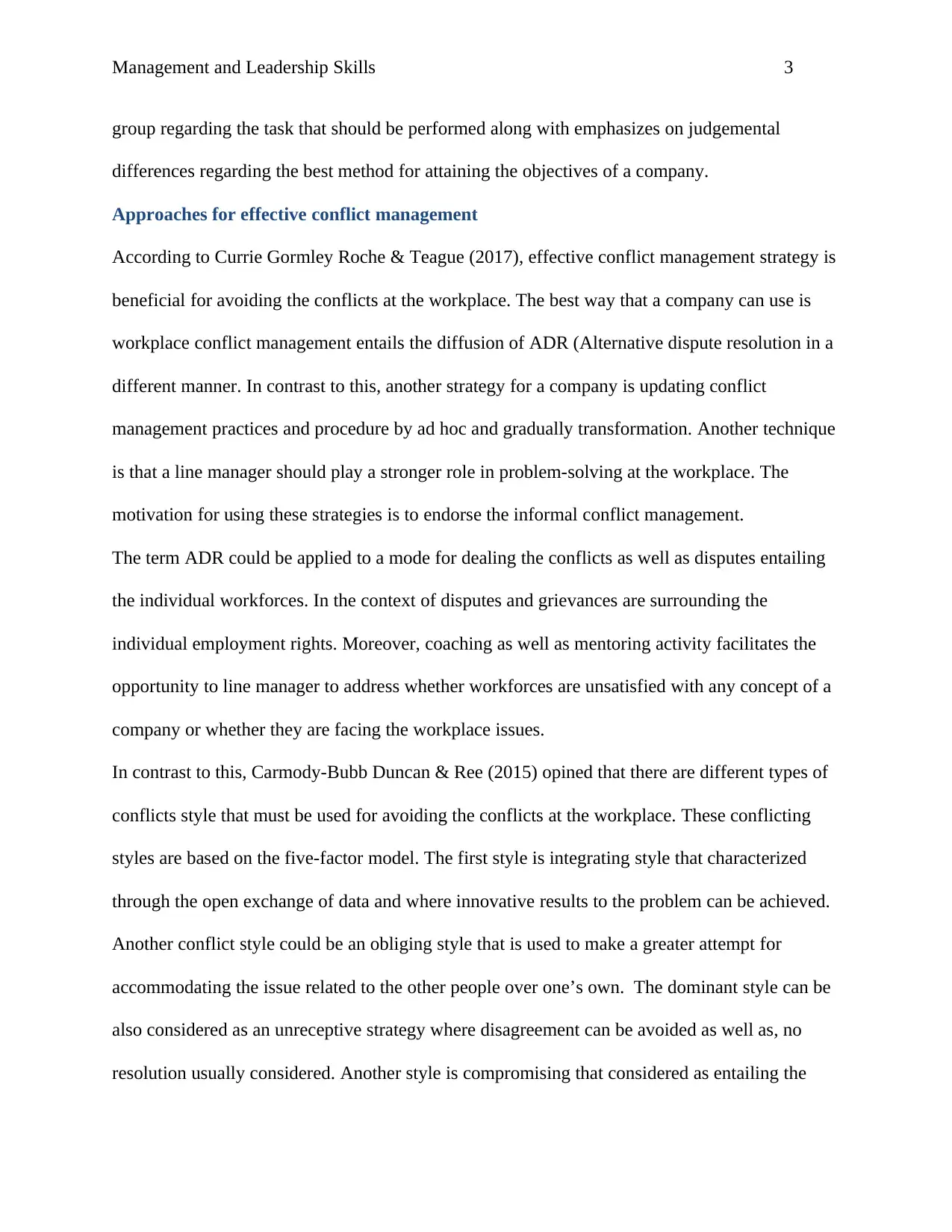
Management and Leadership Skills 3
group regarding the task that should be performed along with emphasizes on judgemental
differences regarding the best method for attaining the objectives of a company.
Approaches for effective conflict management
According to Currie Gormley Roche & Teague (2017), effective conflict management strategy is
beneficial for avoiding the conflicts at the workplace. The best way that a company can use is
workplace conflict management entails the diffusion of ADR (Alternative dispute resolution in a
different manner. In contrast to this, another strategy for a company is updating conflict
management practices and procedure by ad hoc and gradually transformation. Another technique
is that a line manager should play a stronger role in problem-solving at the workplace. The
motivation for using these strategies is to endorse the informal conflict management.
The term ADR could be applied to a mode for dealing the conflicts as well as disputes entailing
the individual workforces. In the context of disputes and grievances are surrounding the
individual employment rights. Moreover, coaching as well as mentoring activity facilitates the
opportunity to line manager to address whether workforces are unsatisfied with any concept of a
company or whether they are facing the workplace issues.
In contrast to this, Carmody-Bubb Duncan & Ree (2015) opined that there are different types of
conflicts style that must be used for avoiding the conflicts at the workplace. These conflicting
styles are based on the five-factor model. The first style is integrating style that characterized
through the open exchange of data and where innovative results to the problem can be achieved.
Another conflict style could be an obliging style that is used to make a greater attempt for
accommodating the issue related to the other people over one’s own. The dominant style can be
also considered as an unreceptive strategy where disagreement can be avoided as well as, no
resolution usually considered. Another style is compromising that considered as entailing the
group regarding the task that should be performed along with emphasizes on judgemental
differences regarding the best method for attaining the objectives of a company.
Approaches for effective conflict management
According to Currie Gormley Roche & Teague (2017), effective conflict management strategy is
beneficial for avoiding the conflicts at the workplace. The best way that a company can use is
workplace conflict management entails the diffusion of ADR (Alternative dispute resolution in a
different manner. In contrast to this, another strategy for a company is updating conflict
management practices and procedure by ad hoc and gradually transformation. Another technique
is that a line manager should play a stronger role in problem-solving at the workplace. The
motivation for using these strategies is to endorse the informal conflict management.
The term ADR could be applied to a mode for dealing the conflicts as well as disputes entailing
the individual workforces. In the context of disputes and grievances are surrounding the
individual employment rights. Moreover, coaching as well as mentoring activity facilitates the
opportunity to line manager to address whether workforces are unsatisfied with any concept of a
company or whether they are facing the workplace issues.
In contrast to this, Carmody-Bubb Duncan & Ree (2015) opined that there are different types of
conflicts style that must be used for avoiding the conflicts at the workplace. These conflicting
styles are based on the five-factor model. The first style is integrating style that characterized
through the open exchange of data and where innovative results to the problem can be achieved.
Another conflict style could be an obliging style that is used to make a greater attempt for
accommodating the issue related to the other people over one’s own. The dominant style can be
also considered as an unreceptive strategy where disagreement can be avoided as well as, no
resolution usually considered. Another style is compromising that considered as entailing the
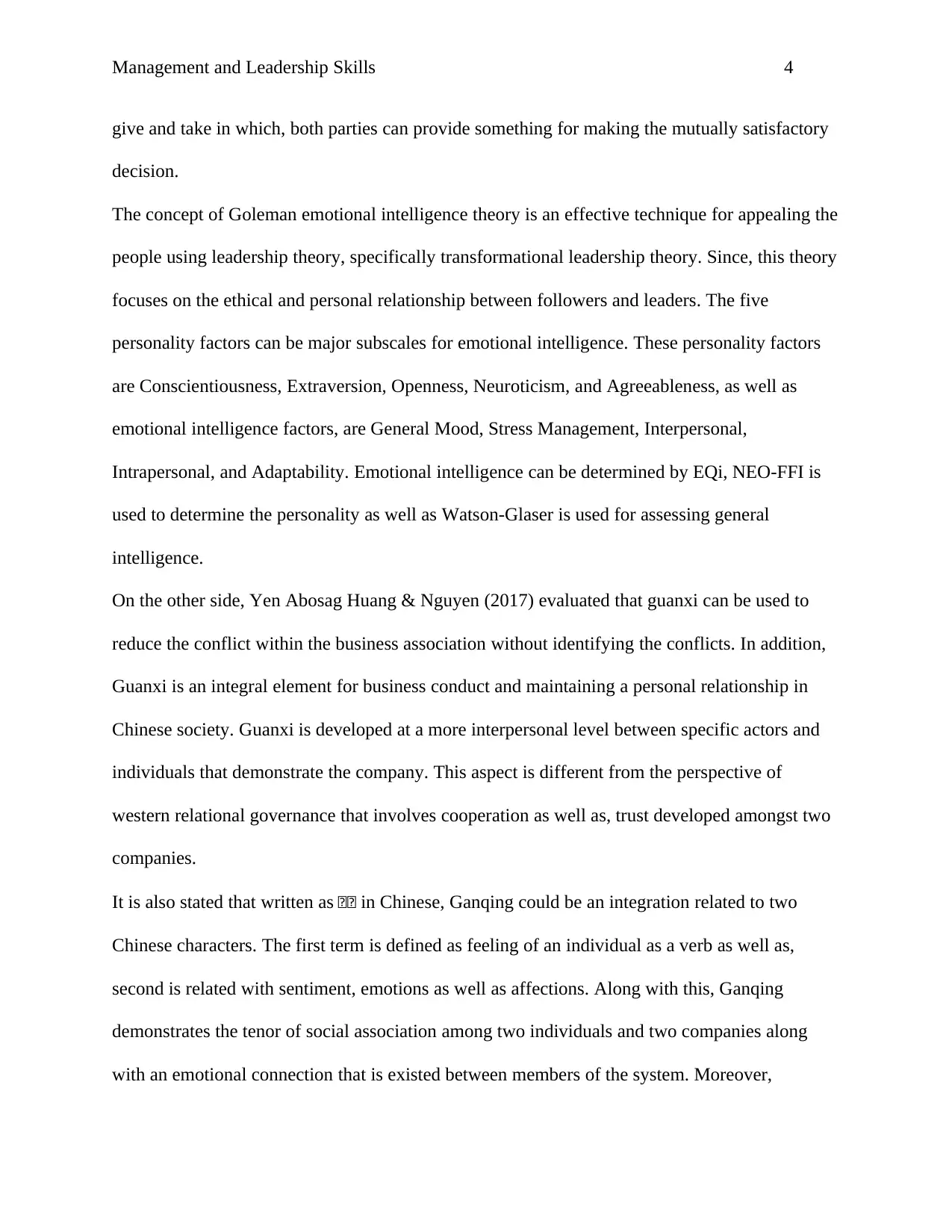
Management and Leadership Skills 4
give and take in which, both parties can provide something for making the mutually satisfactory
decision.
The concept of Goleman emotional intelligence theory is an effective technique for appealing the
people using leadership theory, specifically transformational leadership theory. Since, this theory
focuses on the ethical and personal relationship between followers and leaders. The five
personality factors can be major subscales for emotional intelligence. These personality factors
are Conscientiousness, Extraversion, Openness, Neuroticism, and Agreeableness, as well as
emotional intelligence factors, are General Mood, Stress Management, Interpersonal,
Intrapersonal, and Adaptability. Emotional intelligence can be determined by EQi, NEO-FFI is
used to determine the personality as well as Watson-Glaser is used for assessing general
intelligence.
On the other side, Yen Abosag Huang & Nguyen (2017) evaluated that guanxi can be used to
reduce the conflict within the business association without identifying the conflicts. In addition,
Guanxi is an integral element for business conduct and maintaining a personal relationship in
Chinese society. Guanxi is developed at a more interpersonal level between specific actors and
individuals that demonstrate the company. This aspect is different from the perspective of
western relational governance that involves cooperation as well as, trust developed amongst two
companies.
It is also stated that written as 感感 in Chinese, Ganqing could be an integration related to two
Chinese characters. The first term is defined as feeling of an individual as a verb as well as,
second is related with sentiment, emotions as well as affections. Along with this, Ganqing
demonstrates the tenor of social association among two individuals and two companies along
with an emotional connection that is existed between members of the system. Moreover,
give and take in which, both parties can provide something for making the mutually satisfactory
decision.
The concept of Goleman emotional intelligence theory is an effective technique for appealing the
people using leadership theory, specifically transformational leadership theory. Since, this theory
focuses on the ethical and personal relationship between followers and leaders. The five
personality factors can be major subscales for emotional intelligence. These personality factors
are Conscientiousness, Extraversion, Openness, Neuroticism, and Agreeableness, as well as
emotional intelligence factors, are General Mood, Stress Management, Interpersonal,
Intrapersonal, and Adaptability. Emotional intelligence can be determined by EQi, NEO-FFI is
used to determine the personality as well as Watson-Glaser is used for assessing general
intelligence.
On the other side, Yen Abosag Huang & Nguyen (2017) evaluated that guanxi can be used to
reduce the conflict within the business association without identifying the conflicts. In addition,
Guanxi is an integral element for business conduct and maintaining a personal relationship in
Chinese society. Guanxi is developed at a more interpersonal level between specific actors and
individuals that demonstrate the company. This aspect is different from the perspective of
western relational governance that involves cooperation as well as, trust developed amongst two
companies.
It is also stated that written as 感感 in Chinese, Ganqing could be an integration related to two
Chinese characters. The first term is defined as feeling of an individual as a verb as well as,
second is related with sentiment, emotions as well as affections. Along with this, Ganqing
demonstrates the tenor of social association among two individuals and two companies along
with an emotional connection that is existed between members of the system. Moreover,
Secure Best Marks with AI Grader
Need help grading? Try our AI Grader for instant feedback on your assignments.

Management and Leadership Skills 5
business length association restrained the anticipated set related to association between GRX to
task conflict as well as, increases the emotional attachment with business length association,
declining the impact of GRX on emotional and conflicts in tasks.
Conclusion
From the above interpretation, it can be concluded that there are different reason causing the
conflict. These are market relations, trade unions entering into a collective agreement, lack of
trust, and Emotional conflicts. It can be summarised that there are several approaches to manage
the conflict such as alternative dispute resolution principle, types of conflicts style such as
integrating style, obliging style, dominant style and compromising and five personality factors,
and Goleman emotional intelligence theory. Other approaches are guanxi and Ganqing.
business length association restrained the anticipated set related to association between GRX to
task conflict as well as, increases the emotional attachment with business length association,
declining the impact of GRX on emotional and conflicts in tasks.
Conclusion
From the above interpretation, it can be concluded that there are different reason causing the
conflict. These are market relations, trade unions entering into a collective agreement, lack of
trust, and Emotional conflicts. It can be summarised that there are several approaches to manage
the conflict such as alternative dispute resolution principle, types of conflicts style such as
integrating style, obliging style, dominant style and compromising and five personality factors,
and Goleman emotional intelligence theory. Other approaches are guanxi and Ganqing.
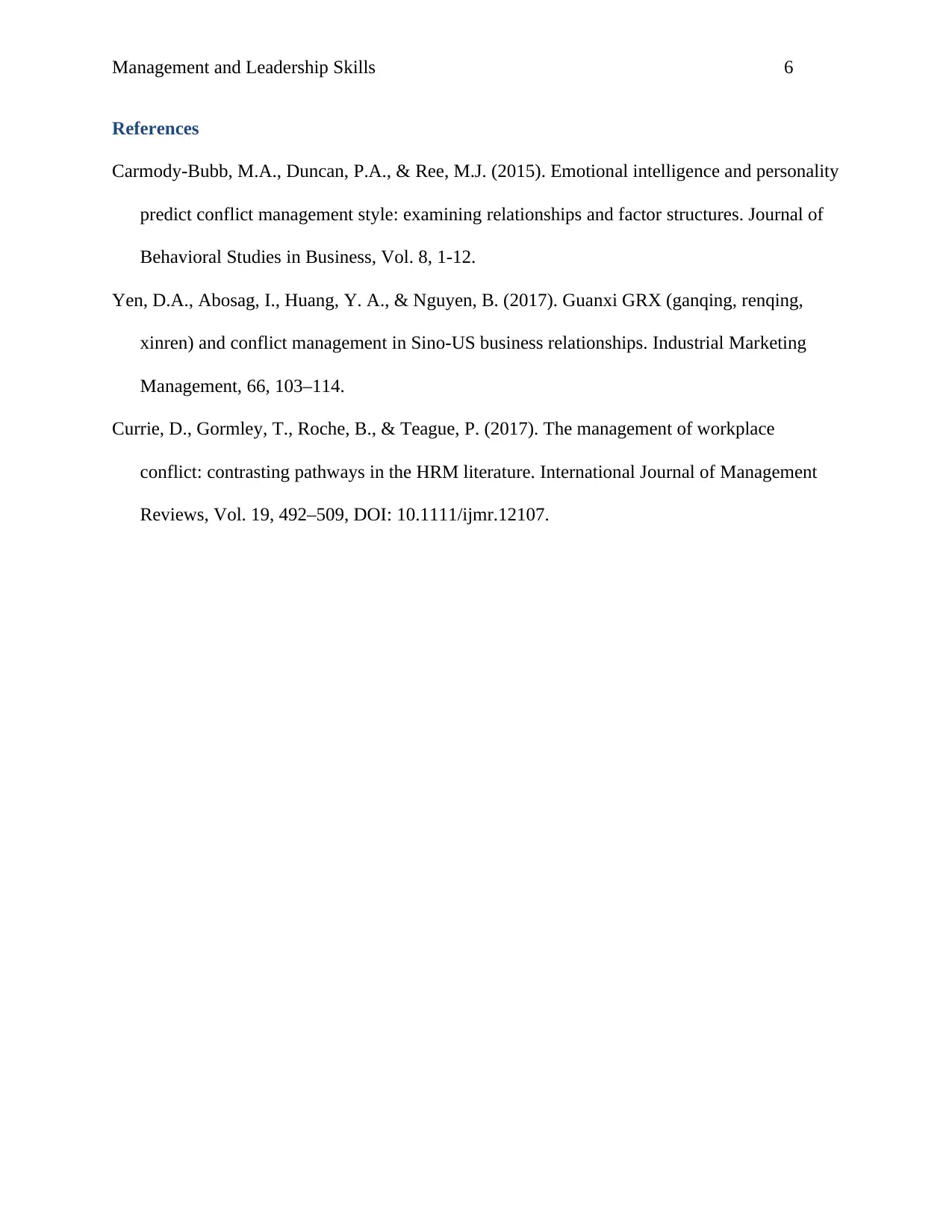
Management and Leadership Skills 6
References
Carmody-Bubb, M.A., Duncan, P.A., & Ree, M.J. (2015). Emotional intelligence and personality
predict conflict management style: examining relationships and factor structures. Journal of
Behavioral Studies in Business, Vol. 8, 1-12.
Yen, D.A., Abosag, I., Huang, Y. A., & Nguyen, B. (2017). Guanxi GRX (ganqing, renqing,
xinren) and conflict management in Sino-US business relationships. Industrial Marketing
Management, 66, 103–114.
Currie, D., Gormley, T., Roche, B., & Teague, P. (2017). The management of workplace
conflict: contrasting pathways in the HRM literature. International Journal of Management
Reviews, Vol. 19, 492–509, DOI: 10.1111/ijmr.12107.
References
Carmody-Bubb, M.A., Duncan, P.A., & Ree, M.J. (2015). Emotional intelligence and personality
predict conflict management style: examining relationships and factor structures. Journal of
Behavioral Studies in Business, Vol. 8, 1-12.
Yen, D.A., Abosag, I., Huang, Y. A., & Nguyen, B. (2017). Guanxi GRX (ganqing, renqing,
xinren) and conflict management in Sino-US business relationships. Industrial Marketing
Management, 66, 103–114.
Currie, D., Gormley, T., Roche, B., & Teague, P. (2017). The management of workplace
conflict: contrasting pathways in the HRM literature. International Journal of Management
Reviews, Vol. 19, 492–509, DOI: 10.1111/ijmr.12107.
1 out of 6
Your All-in-One AI-Powered Toolkit for Academic Success.
+13062052269
info@desklib.com
Available 24*7 on WhatsApp / Email
![[object Object]](/_next/static/media/star-bottom.7253800d.svg)
Unlock your academic potential
© 2024 | Zucol Services PVT LTD | All rights reserved.
